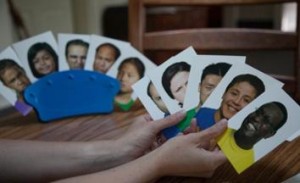Diagnosis and Treatment of Childhood Apraxia of Speech (CAS) Part Two of a Series
April 4, 2016Caring For Your Baby with Cerebral Palsy
April 26, 2016By Tamara Guo, M.Ed., TEIS Developmental Specialist and Laura Danforth, StagesLearning.com
Developmentally, some experts say that young children don’t fully understand emotions and feelings until around school age. And I’m sure we know a lot of adults who don’t seem to understand our feelings! Learning to recognize feelings may not come naturally to all children, especially some children with special needs. Learning about feelings, emotions, empathy, sympathy and compassion require teaching as well as learning through experience and this is a gradual developmental process from infancy.
So, the good news is that you can start teaching your child about emotions and feelings from a very early age!
How can you begin help your child understand his feelings and to recognize the feelings of others?
1) Simply start by labeling your child’s experiences and emotions on a daily basis, even before your child is verbal. For example, “You are so sad that grandma left, it’s ok to cry”, “That boo boo really hurt, mommy will kiss it so you feel better”, “You are SO mad that Tommy took your truck, but it’s not ok to hit, let’s go ask Tommy for your truck.”, “That ice cream is really making your hands cold, brrrrrr”, “Those blocks are really hard to connect together, you’re really trying, but it’s frustrating, let me help you!”.
2) Use books with pictures of real faces or look at magazines and help your toddler identify the emotions by saying things such as “Boy, he really looks mad” or “Awww,that baby is sad, he’s crying” or “Look! He is so surprised his Mommy came home early!”
3) Use stuffed animals, dolls, puppets or action figures to act out and model scenarios for toddlers that involve feelings. For example, “The elephant hit the tiger because he ate his last cookie, the elephant is so mad”, or “Batman fell off his Batcycle and scrapped his knee, he is crying because it hurts and he is sad”.
4) If you do an Amazon search you will also find many books geared specifically toward young children such as “The Feelings Book” by Todd Parr or “I’m Feeling Mad” by Natalie Shaw and Jason Fruchter and many, many more great choices.
As your toddler approaches preschool age there are many more ways to work on identifying feelings. The above activities and the activity below can be nice ways to work on feeling and emotion identification with children, including children on the Autism Spectrum.
Fun Project to Learn about Emotions!
We’ve seen how children can go through a wide range of emotions in a short time – sometimes over just a few minutes! But it can be tricky to teach the names of these feelings, because we don’t always say them out loud in the same way we would repeat the name of an object that we’re teaching. It’s helpful to use fun activities to help your child learn what that particular feeling is called when they receive a fun new toy or when they trip and fall down.
Stages Learning, which creates learning tools for preschool children and children with Autism, sells a set of Emotion Flash Cards for teaching the names of feelings to children. Each flash card shows the face of a person experiencing a different emotion. You can go through each facial expression and see if your child can identify the emotion on the card.
After reviewing the Stages Emotion Flash Cards, a fun way to get hands on is to make a Feelings Box with your child! Children will love decorating the box and this is a great way to help them think about the different feelings they experience.
You will need:
-Shoebox
-Acrylic paint with assorted colors
-Water
-Paint brush
-Coloring materials with assorted colors (such as markers, crayons, or colored pencils)
-11 x 14 inch plain white paper
-Scissors
-Mod Podge or other craft glue
Steps:
1. Help your child fold a paper into 12 boxes and ask them to name various emotions that could go into the boxes.
2. Assist your child in drawing a symbol for each emotion in each box.
3. Cut out the boxes to make cards.
4. Show your child a shoebox and ask him/her what color represents what they feel on the inside – and what color represents what they show on the outside. Your child will then paint the box with acrylic paint with your assistance.
5. Help your child to paste cards that represent how they feel on the outside onto the outside of the box and how they feel on the inside onto the inside of the box.


 Send to a friend!
Send to a friend!